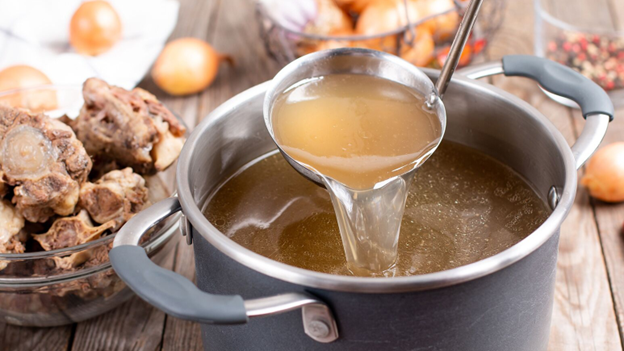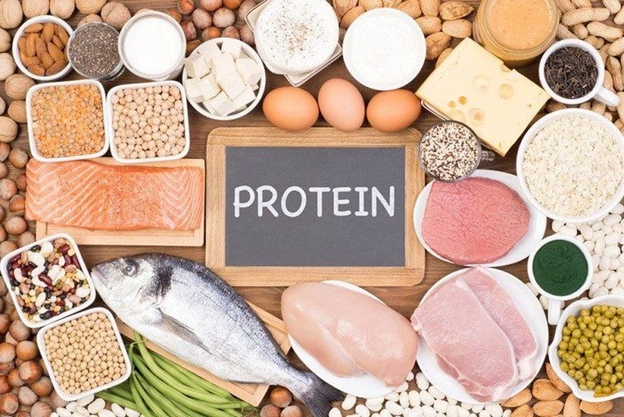 English
EnglishThe concept of “You are what you eat” in bone and joint diseases: From misconception to scientific evidence
Does eating tendons really nourish tendons? Is bone broth as rich in calcium as rumored? This article will clarify the scientific truth behind the belief that “You are what you eat” in improving musculoskeletal diseases. The article analyzes in depth the biological mechanism, explaining why the body does not directly transport nutrients to the joints. At the same time, based on the scientific foundation, nutritional recommendations are made to build a diet that scientifically supports bone and joint health.
“You are what you eat”: Folk beliefs and the lens of modern medicine

There are many folk beliefs about foods that are good for bones and joints
In the treasure trove of Vietnamese folk experience, the concept of “You are what you eat” has become a deep belief, passed down from generation to generation. We often hear adults advise that eating brains is good for the brain, eating hearts is good for the heart, and especially popular is the belief that consuming tendons, cartilage or stewed bones directly helps the motor system become strong and flexible. This is an intuitive, easy-to-understand concept and expresses the desire to improve health in a close way. However, when viewed through the lens of modern medicine and nutritional science, the mechanism of food’s impact on the body is much more complex and sophisticated.
The truth about digestion is key. Our bodies do not function as mechanical adders, where a foreign part is introduced to directly replace or repair an internal counterpart. When we eat a food, say a piece of cartilage, the digestive system initiates a complex biochemical breakdown process. Enzymes in the stomach and small intestine act as “factories,” breaking down complex protein structures (like collagen) into their smallest building blocks, amino acids and short peptide chains. Likewise, minerals like calcium are released from the food structure so they can be absorbed.
Only after being broken down into these basic “bricks” can they be absorbed through the intestinal wall, enter the bloodstream and be distributed throughout the body. Here, the body will use amino acids and minerals to synthesize the necessary structures according to its physiological needs. Therefore, the body cannot “take” a whole piece of cartilage you eat and “put” it on your knee joint. Instead, it takes amino acids from that piece of cartilage as raw materials to rebuild its own cartilage tissue.
Eating tendons, cartilage, bone broth: Where do the real benefits come from?
Although not as directly “nutritious” as is commonly believed, these foods still contain valuable nutrients. It is important that we understand exactly where their benefits come from and how to optimize those benefits.
Is eating tendons and pig’s feet really “good for tendons”?

Eating tendons nourishes tendons – A folk belief trusted by many people
Many people believe that regularly eating dishes such as stir-fried beef tendons and stewed pig’s feet allows the body’s tendon and ligament system to become more flexible and elastic. Scientific analysis shows that tendons and pig’s feet are a food source rich in type I collagen. This is the main structural protein that makes up tendons, ligaments, skin, and bones in the human body. When consumed, this amount of collagen is broken down by the digestive system into specific amino acids, mainly glycine, proline, and hydroxyproline.
The real benefit of eating tendons is that they provide the body with a rich source of specialized “raw materials” to synthesize its own collagen. Eating tendons does not “nourish” directly, but rather provides building materials. When the body is provided with enough of these amino acids, the process of repairing and maintaining connective tissues will take place more effectively.
For the body to synthesize collagen effectively, amino acids alone are not enough. This process requires an indispensable catalyst, Vitamin C. Without enough Vitamin C, the process of forming strong collagen fibers will stagnate. Therefore, a smart combination is to consume tendons and stewed pig’s feet with vegetables rich in Vitamin C such as bell peppers, broccoli, tomatoes, or simply drink a glass of orange juice after meals.
Eating cartilage regenerates joint cartilage or not?
A popular belief among the people is that eating chicken and pork cartilage is believed to thicken worn-out cartilage, thereby reducing pain and improving mobility. However, from a scientific perspective, animal cartilage contains the main components of collagen type II and glycosaminoglycans including glucosamine and chondroitin. Similar to collagen type E, they are also broken down into smaller structural units during digestion before being absorbed.
Eating cartilage provides the “precursors” that the body can use for the repair and maintenance of joint cartilage structures. Some studies on functional foods have shown that using hydrolyzed collagen or undenatured type II collagen has shown benefits in reducing pain and improving joint function in patients with osteoarthritis. However, eating raw cartilage from foods such as chicken cartilage or pork cartilage is not as effective in absorption and bioavailability as specially processed forms.
So, instead of focusing on eating cartilage alone, it is advisable to combine it with an anti-inflammatory diet. The reason is that chronic inflammation produces enzymes that destroy cartilage. Increasing foods rich in Omega-3 (found in fatty fish) enables protection of existing cartilage from destruction by inflammation.
Is bone broth a “miracle drug” for strong bones?

Bone broth is said to be rich in calcium, which is good for bones and joints
Bone broth has long been considered to contain all the essence, especially calcium from bone marrow and help strengthen bones. However, from a scientific perspective, this is probably the biggest misconception. Many studies analyzing the chemical composition have shown that the calcium and magnesium content in bone broth is actually very low. Calcium is a mineral with a very stable structure in the hydroxyapatite network of bones and is not easily dissolved in water by conventional cooking methods, even when simmered for a long time.
Although not rich in calcium, bone broth still has its own nutritional value. Specifically, bone broth contains a lot of gelatin, which is cooked collagen, providing amino acids and some trace minerals. Therefore, this type of broth helps provide water, is easy to digest, soothes the intestines and is a nutritious dish, especially for sick people. But the truth is, bone broth is not a rich source of calcium.
Therefore, to effectively supplement Calcium for bones, we need to find truly abundant and highly bioavailable sources such as: milk, yogurt, cheese, small fish eaten with bones (sardines, anchovies), dark green leafy vegetables (spinach, kale, broccoli) and beans.
So what is the real “bone and joint health” diet?
A healthy skeletal system is not built from a few single foods, but is the result of a comprehensive, scientific and sustainable nutritional strategy.
Provides complete “building materials”: Protein & Amino acids

Protein – an important ingredient for strong bones
The skeleton and cartilage are based on protein, mainly collagen. Therefore, ensuring a sufficient daily supply of high-quality protein is a must so that the body has enough amino acids for the synthesis of collagen and other joint structures.
Food sources for protein supplementation should come from both animals including lean meat, fish, eggs, milk and products and plant sources including beans, soybeans, seeds, etc. for the most diversity.
Supplement important micronutrients
Calcium, vitamin D3, vitamin K2 and magnesium are considered the indispensable quartet for strong bones. An easy comparison is that calcium is the “brick”, vitamin D3 helps “absorb bricks”, vitamin K2 is the “transporter” that brings bricks to the right construction site, which is the bone, and magnesium participates in the bone mineralization process.
To support the collagen synthesis process, vitamin C is indispensable. This is an essential transport medium for collagen synthesis as well as creating strong cross-links between collagen fibers. Natural sources of vitamin C are found in juicy fruits such as oranges, tangerines, grapes, kiwi, guava and green vegetables such as broccoli and kale,..
Controlling the “destroyer”: The anti-inflammatory diet
The inflammatory process produces many enzymes that destroy cartilage. Therefore, reducing inflammatory factors and enhancing anti-inflammatory factors is extremely important to protect joints from the erosion and destruction of chronic inflammatory reactions. In our daily diet, we should limit sugar, saturated fat and increase Omega-3 (from fatty fish), along with antioxidants from colorful vegetables and fruits such as broccoli, purple cabbage, etc., which are considered key strategies.
Ensuring a sufficient and balanced supply of all the above mentioned micronutrients – from the “building materials” for cartilage, the “four” for bones to the “anti-inflammatory” factors – through daily diet can be a challenge, especially for the elderly or those with poor digestive absorption. This is where medical nutritional solutions specifically researched for multi-targeted effects play an indispensable role.
Researched and developed by Nutricare and the Nutricare Medical Nutrition Institute – USA (NMNI-USA), Nutricare Bone is a nutritional solution to improve bone and joint health.
Nutricare Bone’s nutritional formula provides Glucosamine from the US, an important component of cartilage tissue, clinically proven to support increased synovial fluid production, increasing joint flexibility and suppleness.
Not only that, the product also strengthens the “foundation” of bones supporting joints with the trio of Calcium, vitamin D3 and vitamin K2 with an outstandingly high Calcium content of 1800mg to help prevent osteoporosis, ensure calcium is absorbed and transported to the right location in the bones, maximize the body’s effectiveness in using Calcium, and support strong bones.
Conclusion
The concept of “You are what you eat” is not entirely wrong, but it is flawed. Eating tendons, cartilage or bone broth is actually a way for us to provide the body with “raw materials” such as collagen, gelatin and amino acids. However, the body will break them down into the smallest units before synthesizing them, and cannot “apply” them directly to the corresponding parts. The real benefits only come when we combine these “ingredients” with a comprehensive diet: enough protein, enough important “catalysts” such as Vitamin C, Calcium, D3, K2, and especially an anti-inflammatory environment to protect joints from destruction.

Nutrition to support bones and joints
So, instead of just focusing on a few “word of mouth” dishes, build a diverse, balanced menu. That is the smartest and most sustainable nutritional strategy for a flexible and healthy skeletal system.
References:
|
